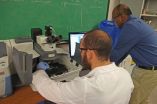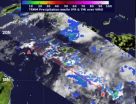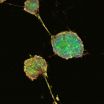(Press-News.org) Like job-seekers searching for a new position, living things sometimes have to pick up a new skill if they are going to succeed. Researchers from the University of California, Davis, and Uppsala University, Sweden, have shown for the first time how living organisms do this.
The observation, published Oct. 19 in the journal Science, closes an important gap in the theory of natural selection.
Scientists have long wondered how living things evolve new functions from a limited set of genes. One popular explanation is that genes duplicate by accident; the duplicate undergoes mutations and picks up a new function; and, if that new function is useful, the gene spreads.
"It's an old idea and it's clear that this happens," said John Roth, a distinguished professor of microbiology at UC Davis and co-author of the paper.
The problem, Roth said, is that it has been hard to imagine how it occurs. Natural selection is relentlessly efficient in removing mutated genes: Genes that are not positively selected are quickly lost.
How then does a newly duplicated gene stick around long enough to pick up a useful new function that would be a target for positive selection?
Experiments in Roth's laboratory and elsewhere led to a model for the origin of a novel gene by a process of "innovation, amplification and divergence." This model has now been tested by Joakim Nasvall, Lei Sun and Dan Andersson at Uppsala.
In the new model, the original gene first gains a second, weak function alongside its main activity — just as an auto mechanic, for example, might develop a side interest in computers. If conditions change such that the side activity becomes important, then selection of this side activity favors increasing the expression of the old gene. In the case of the mechanic, a slump in the auto industry or boom in the IT sector might lead her to hone her computer skills and look for an IT position.
The most common way to increase gene expression is by duplicating the gene, perhaps multiple times. Natural selection then works on all copies of the gene. Under selection, the copies accumulate mutations and recombine. Some copies develop an enhanced side function. Other copies retain their original function.
Ultimately, the cell winds up with two distinct genes, one providing each activity — and a new genetic function is born.
Nasvall, Lei and Andersson tested this model using the bacterium Salmonella. The bacteria carried a gene involved in making the amino acid histidine that had a secondary, weak ability to contribute to the synthesis of another amino acid, tryptophan. In their study, they removed the main tryptophan-synthesis gene from the bacteria and watched what happened.
After growing the bacteria for 3,000 generations on a culture medium without tryptophan, they forced the bacteria to evolve a new mechanism for producing the amino acid. What emerged was a tryptophan-synthesizing activity provided by a duplicated copy of the original gene.
"The important improvement offered by our model is that the whole process occurs under constant selection — there's no time off from selection during which the extra copy could be lost," Roth said.
###
The work was supported by the Swedish Research Council and the National Institutes of Health.
Evolution of new genes captured
2012-10-23
ELSE PRESS RELEASES FROM THIS DATE:
Rapid changes in the Earth's core: The magnetic field and gravity from a satellite perspective
2012-10-23
Annual to decadal changes in the earth's magnetic field in a region that stretches from the Atlantic to the Indian Ocean have a close relationship with variations of gravity in this area. From this it can be concluded that outer core processes are reflected in gravity data. This is the result presented by a German-French group of geophysicists in the latest issue of PNAS (Proceedings of the National Academy of Sciences of the United States).
The main field of the Earth's magnetic field is generated by flows of liquid iron in the outer core. The Earth's magnetic field protects ...
New Stanford analysis provides fuller picture of human expansion from Africa
2012-10-23
A new, comprehensive review of humans' anthropological and genetic records gives the most up-to-date story of the "Out of Africa" expansion that occurred about 45,000 to 60,000 years ago.
This expansion, detailed by three Stanford geneticists, had a dramatic effect on human genetic diversity, which persists in present-day populations. As a small group of modern humans migrated out of Africa into Eurasia and the Americas, their genetic diversity was substantially reduced.
In studying these migrations, genomic projects haven't fully taken into account the rich archaeological ...
Milky Way's black hole getting ready for snack
2012-10-23
Get ready for a fascinating eating experience in the center of our galaxy.
The event involves a black hole that may devour much of an approaching cloud of dust and gas known as G2.
A supercomputer simulation prepared by two Lab physicists and a former postdoc suggests that some of G2 will survive, although its surviving mass will be torn apart, leaving it with a different shape and questionable fate.
The findings are the work of computational physicist Peter Anninos and astrophysicist Stephen Murray, both of AX division within the Weapons and Complex Integration Directorate ...
New self-healing coating for aluminum developed to replace cancer-causing product
2012-10-23
RENO, Nev. – A research team at the University of Nevada, Reno has developed a new environmentally-friendly coating for aluminum to replace the carcinogenic chromate coatings used in aerospace applications. The chromate conversion coatings have been used for more than 50 years to protect aluminum from corrosion.
The team presented their research last week at the international Pacific Rim Meeting on Electrochemical and Solid-State Science in Hawaii.
"It was well received at the conference," Dev Chidambaram, lead scientist and assistant professor of materials science ...
NASA sees 18th Atlantic depression form
2012-10-23
Tropical Depression 18 (TD18) formed over the southwestern Caribbean Sea at 11 a.m. EDT on Oct. 22, and NASA's TRMM satellite saw a "hot towering" thunderstorm near its center of circulation hinting that it could become a tropical storm soon. A tropical storm watch has been issued for Jamaica.
When NASA's Tropical Rainfall Measuring Mission (TRMM) satellite flew over the developing TD18 early on Oct. 22 at 0040 UTC (Oct. 21 at 8:40 p.m. EDT), the satellite measured rainfall rates within the low pressure area and measured cloud heights of the thunderstorms that make up ...
Additive restores antibiotic effectiveness against MRSA
2012-10-23
Researchers from North Carolina State University have increased the potency of a compound that reactivates antibiotics against methicillin-resistant Staphylococcus aureus (MRSA), an antibiotic-resistant form of Staphylococcus that is notoriously difficult to treat. Their improved compound removes the bacteria's antibiotic resistance and allows the antibiotic to once again become effective at normal dosage levels.
NC State chemist Christian Melander had previously proven the effectiveness of a 2-aminoimidazole compound in reactivating antibiotics against resistant bacterial ...
Crusty foods may worsen heart problems associated with diabetes
2012-10-23
URBANA – A University of Illinois study suggests avoiding cooking methods that produce the kind of crusty bits you'd find on a grilled hamburger, especially if you have diabetes and know you're at increased risk for cardiovascular disease because of your diagnosis.
"We see evidence that cooking methods that create a crust—think the edge of a brownie or the crispy borders of meats prepared at very high temperatures—produce advanced glycation end products (AGEs). And AGEs are associated with plaque formation, the kind we see in cardiovascular disease," said Karen Chapman-Novakofski, ...
New study suggests using sedentary behavior counseling in primary care
2012-10-23
HOUSTON – (Oct. 22, 2012) – Although primary care physicians take care of many aspects of health and disease, little is known about how they can change sedentary behavior through counseling, according to researchers at The University of Texas Health Science Center at Houston (UTHealth). Results from a new study suggest encouraging patients to decrease the time they spend sitting each day may be feasible in the primary care setting.
"Reducing sedentary time can be done by virtually everyone and requires smaller changes in energy expenditure than meeting physical activity ...
Aggressive brain tumors can originate from a range of nervous system cells
2012-10-23
LA JOLLA, CA---- Scientists have long believed that glioblastoma multiforme (GBM), the most aggressive type of primary brain tumor, begins in glial cells that make up supportive tissue in the brain or in neural stem cells. In a paper published October 18 in Science Express, however, researchers at the Salk Institute for Biological Studies have found that the tumors can originate from other types of differentiated cells in the nervous system, including cortical neurons.
GBM is one of the most devastating brain tumors that can affect humans. Despite progress in genetic ...
Parenting and temperament in childhood predict later political ideology
2012-10-23
Political mindsets are the product of an individual's upbringing, life experiences, and environment. But are there specific experiences that lead a person to choose one political ideology over another?
New research from psychological scientist R. Chris Fraley of the University of Illinois at Urbana-Champaign and colleagues suggest that parenting practices and childhood temperament may play an influential role. Their study is published online in Psychological Science, a journal of the Association for Psychological Science.
Existing research suggests that individuals ...


